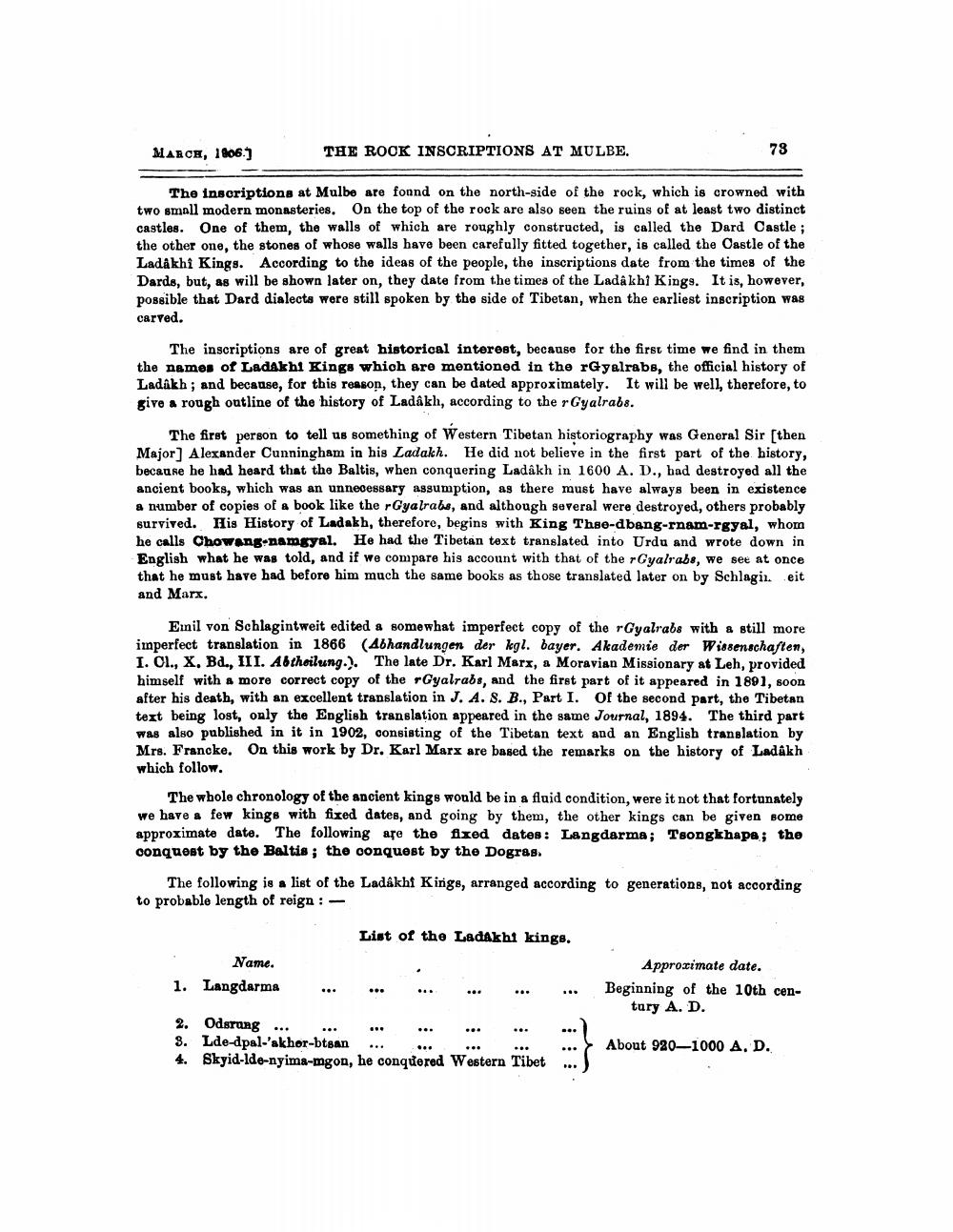________________
MARCH, 1806.)
THE ROCK INSCRIPTIONS AT MULBE.
73
The inscriptions at Mulbe are fonnd on the north-side of the rock, which is crowned with two small modern monasteries. On the top of the rock are also seen the ruins of at least two distinct castles. One of them, the walls of which are roughly constructed, is called the Dard Castle ; the other one, the stones of whose walls have been carefully fitted together, is called the Castle of the Ladakhi Kings. According to the ideas of the people, the inscriptions date from the times of the Dards, but, &s will be shown later on, they date from the times of the Ladakhi Kings. It is, however, possible that Dard dialects were still spoken by the side of Tibetan, when the earliest inscription was carved.
The inscriptions are of great historical interest, because for the first time we find in them the names of Ladakhi Kings which are mentioned in the rgyalrabs, the official history of Ladakh ; and because, for this reason, they can be dated approximately. It will be well, therefore, to give a rough outline of the history of Ladakh, according to the r Gyalrabs.
The first person to tell us something of Western Tibetan historiography was General Sir (then Major) Alexander Cunningham in his Ladakh. He did not believe in the first part of the history, because he had heard that the Baltis, when conquering Ladakh in 1600 A. D., bad destroyed all the ancient books, which was an unnecessary assumption, as there must have always been in existence a number of copies of a book like the rGyalrabs, and although several were destroyed, others probably survived. His History of Ladakh, therefore, begins with King Thse-dbang-rnam-rgyal, whom he calls Chowang namgyal. He had the Tibetan text translated into Urdu and wrote down in English what he was told, and if we compare his account with that of the rGyalrabs, we see at once that he must have had before him much the same books as those translated later on by Schlagi. eit and Marx.
Einil von Schlagintweit edited a somewhat imperfect copy of the rGyalrabs with a still more imperfect translation in 1866 (Abhandlungen der kgl. bayer. Akademie der Wissenschaften, 1. Ol., X. Bd., III. Abtheilung.). The late Dr. Karl Marx, a Moravian Missionary at Leh, provided himself with a more correct copy of the rGyalrabs, and the first part of it appeared in 1891, soon after his death, with an excellent translation in J. A. S. B., Part I. Of the second part, the Tibetan text being lost, only the English translation appeared in the same Journal, 1894. The third part was also published in it in 1902, consisting of the Tibetan text and an English translation by Mrs. Francke. On this work by Dr. Karl Marx are based the remarks on the history of Ladakh which follow.
The whole chronology of the ancient kings would be in a fluid condition, were it not that fortunately we have a few kings with fixed dates, and going by them, the other kings can be given some approximate date. The following are the fixed dates: Langdarma; Tsongkhapa; the conquest by the Baltis; the conquest by the Dogras.
The following is a list of the Ladakhi Kings, arranged according to generations, not according to probable length of reign : -
List of the Ladakht kings.
Name. 1. Langdarma
...
...
Approximate date. Beginning of the 10th cen
tary A. D.
2. Odsrang ... ... 3. Lde-dpal-'akhor-btsan ... 4. Skyid-lde-nyima-mgon, he conquered Western Tibet
About 920—1000 A, D.




